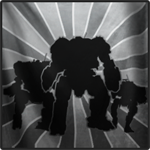 Mizeur, on 22 August 2015 - 12:08 AM, said:
Mizeur, on 22 August 2015 - 12:08 AM, said:
Let's get some stats from PGI on matchmaking quality before making rash suggestions about dissolving the queues. Let's also be clear in evaluating what they did.
-PSR vs Elo exchanges one set of rating problems with another. That's a wash. Honestly, might just be a placebo with the new match score calculation as the sugar pill.
-The most positive thing they did was bucketing players into 5 groups. They also could have kept Elo and just done that.
-The worst thing they did was apply a single rating to an account, ditching the weight class ratings.
Basically, if you wouldn't have been in favor of merging the queues before, you shouldn't be now. Solo queue is a mess because the teams are still a hodgepodge of uncoordinated players. It's effectively an unranked queue moderated by matchmaking. Group queue draws players who want more coordination, organization, or ould otherwise play in a ranked queue. It at least tries to match appropriate groups against each other. We can debate how successful it was and is.
I'd say they're both a mess but better now than when they were combined. A decent 2-man can roll solo PUGs even with matchmaking. Separate queues, not matchmaker, is what solves for balancing self-preservation against the need for collective action.
Ehhhh. ELO and PSR operate under fundamentally different grouping philosophies, both in the solo and group queue.
ELO attempted to match the average rating of one team as closely as possible to the average rating of the opposing team. While players closest to the current mean team ELO were always selected first, this wasn't a guarantee that you didn't get extreme variations in pilot skill.
For example, if you wanted to form a team with an average ELO of 1950, but you had a player with ELO 2350 waiting in the queue, you'd have to balance that player with 4 players at 1850 or 1 player at 1550. This led to some horrific skill gaps on some teams that left a lot of players frustrated, and a lot of games ending with stomps.
PSR attempts to match all players horizontally. It will look at all the Tier 2s in a queue and scoop up 24 of them for a match if it can. If there are only 20 T2s in the queue, it'll scoop up 4 players from the high end of T3 or the low end of T1. It caps the maximum overall tier gap at 2, and therefore refuses to use extremes to achieve a reasonable mean skill rating the way ELO did.
I think this system will work a lot better overall. Horizontal matching is the only reason I feel remotely confident in suggesting that they remove group queue. At the end of the day, even if a team of T1 players drops down against a bunch of solos, those solos are all going to be T1-T2 themselves and they'll have the tools (namely VOIP) to defend themselves.
 Triordinant, on 22 August 2015 - 12:16 AM, said:
Triordinant, on 22 August 2015 - 12:16 AM, said:
Your assumptions are incorrect. It's not TS3 or skill level that causes the imbalance. It's the fact that comp teams train regularly, instinctively know each other's moves, memorize the maps and use 'mechs that are not only fully mastered with max modules, but 'mechs that have been carefully chosen to work together as a team.
Pretty much any player who's in Tier 1 is going to fit all of those criteria, whether they're in a group or not. Memorized maps? Maxed out, moduled mechs? Familiarity with standard tactics? Check, check, and check.
 Kjudoon, on 22 August 2015 - 12:17 AM, said:
Kjudoon, on 22 August 2015 - 12:17 AM, said:
Numbers do not make up the totality of reality, sheldon lee cooper. They have less to do with how people feel and react.
So your alpeal to authority is a failure and gets you no pass. You still dont get what makes many gamers tick.
Er... that wasn't an appeal to authority. That was me wondering what the heck my being a retired comp player had to do with sociology, and an admission that - no - I really am not very great at it.
Edited by Vlad Ward, 22 August 2015 - 12:23 AM.
 Triordinant, on 21 August 2015 - 11:34 PM, said:
Triordinant, on 21 August 2015 - 11:34 PM, said:




















